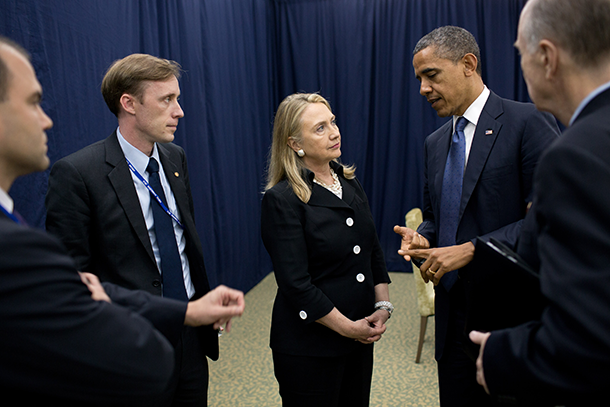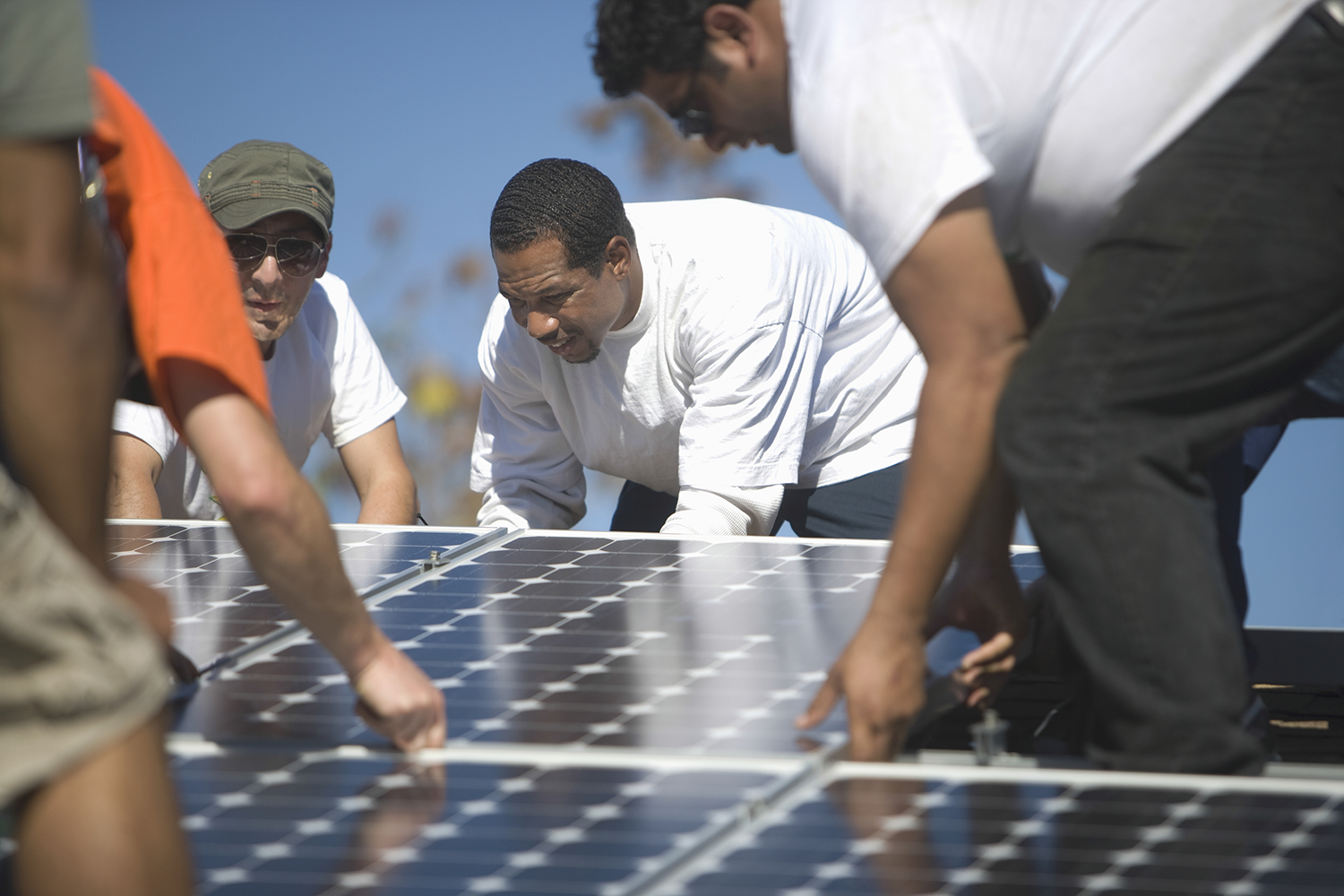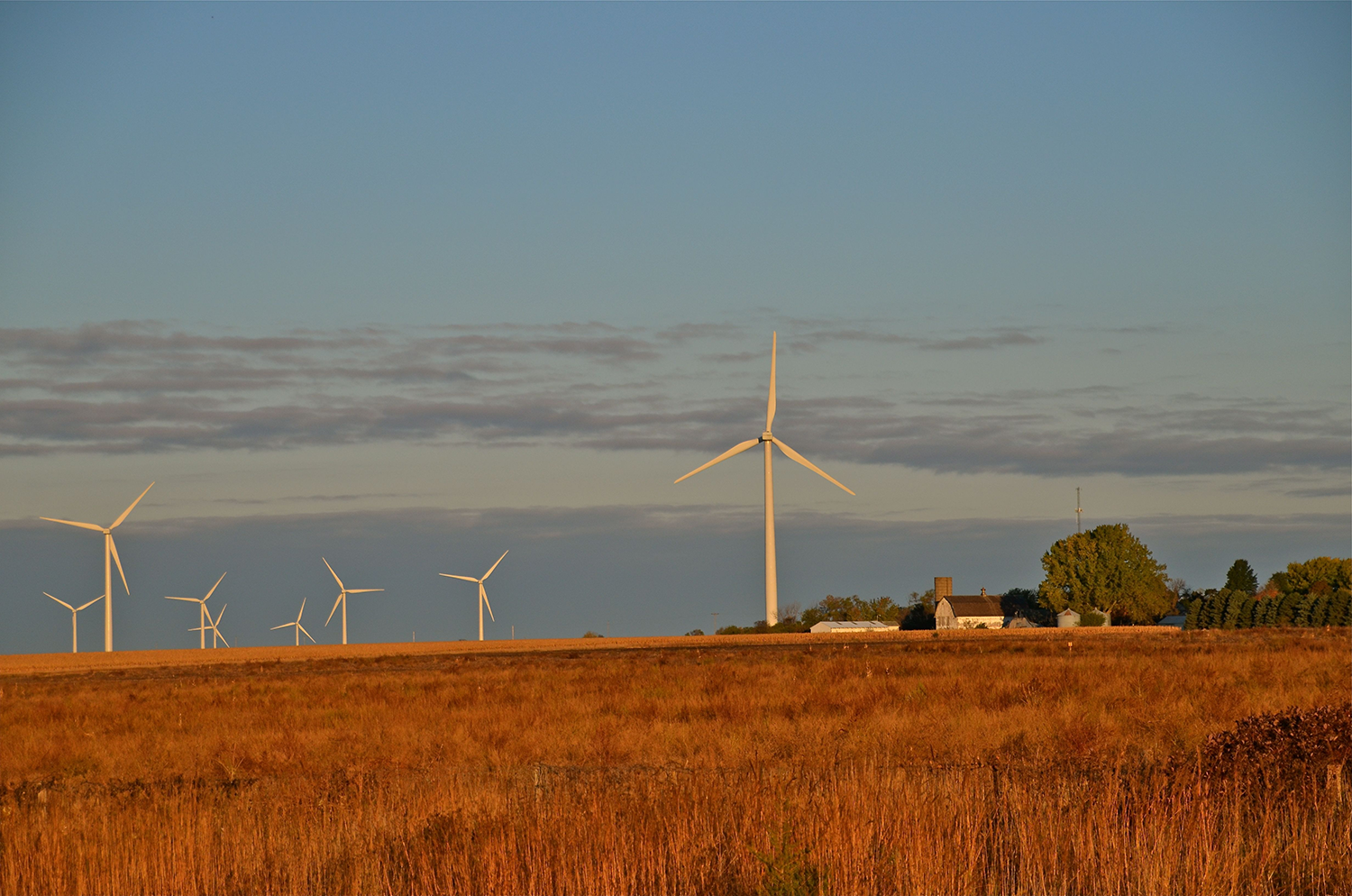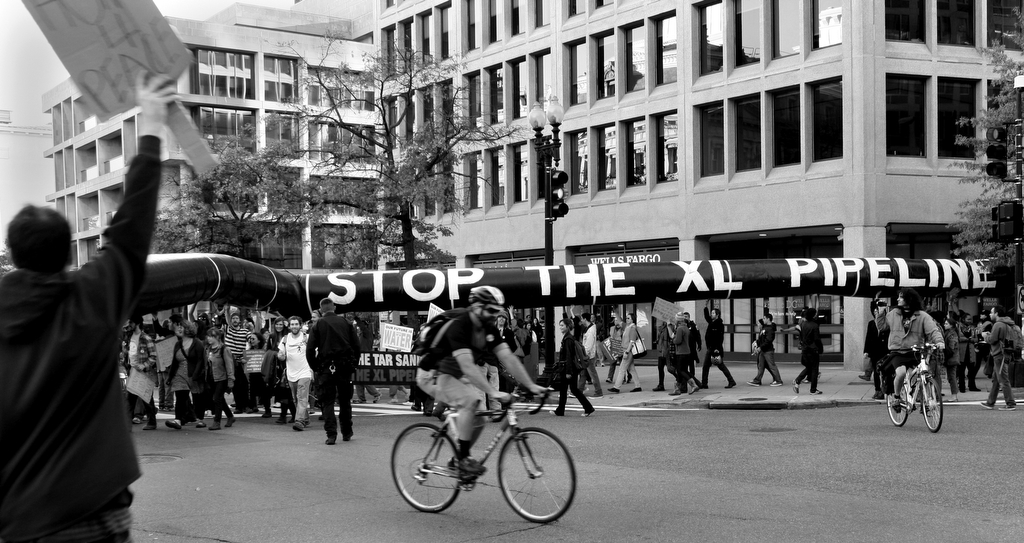The Hillary Clinton Campaign Goes Solar
Air Date: Week of July 31, 2015

Jake Sullivan, former national security advisor to Vice President Biden, and Hillary Clinton, former Secretary of State, speaking with President Barack Obama. (Official White House Photo by Pete Souza)
Democratic Presidential front-runner Hillary Clinton has pledged to create and enlarge market-based incentives to boost renewable energy in the US, as part of her fight against global warming. Her plan includes installing half a billion solar panels in her first four years in office and producing a third of all US electric power from renewable sources by 2027. In conversation with host Steve Curwood, Secretary Clinton’s policy director Jake Sullivan lays out how they plan to meet those goals, and explains Secretary Clinton’s position on controversial fossil fuel projects including Keystone XL.
Transcript
CURWOOD: From the Jennifer and Ted Stanley Studios in Boston and PRI, this is Living on Earth. I’m Steve Curwood. With polling that suggests two-thirds of voters want the next president to address climate change, Hillary Clinton has laid out an ambitious renewable energy plan while campaigning in Iowa and New Hampshire. The present front-runner for the democratic nomination declared she would take action on day one of her presidential term.
CLINTON: First, I will ensure we hit a target of having more than half a billion solar panels installed across the country by the end of my first term. Second, we'll set a ten-year goal of generating enough renewable energy to power every single home in America.
CURWOOD: Jake Sullivan, senior policy analyst for the Clinton campaign says that amounts to about a third of all US electricity, and she’s taking these steps because she believes climate change is one of our defining challenges. Jake Sullivan says her measures build on President Obama’s legacy.
SULLIVAN: So the first step is to defend and implement the smart environmental and public health standards like the Clean Power plan that the President has laid out, and to ensure that that is rigorously implemented and defended against efforts by Republicans in Congress to roll it back. But then beyond that, what the Secretary has talked about is launching what she calls a new Clean Energy Challenge which is essentially a partnership with states, cities, and rural communities that will involve competitive grants and other market-based tools, so anyone who wants to go above and beyond the floor set by the Clean Power plan, anyone who wants to cut red tape that hinders clean energy access and entrepreneurship to invest in a more reliable electrical grid through whatever mechanism or means they think really works. Any city government or state government, there will be resources available to them from the federal government to do that.
CURWOOD: So let's look at your call for a half a billion solar panels by 2020 and in her first term, assuming she would win one. How does that work? How would that work? And what would you require in terms of legislation?

Secretary Clinton is calling for half a billion solar panels in her first term if elected (Photo: Bigstock photo)
SULLIVAN: So a substantial amount of it will be about removing barriers to the deployment of energy through cutting red tape, and that would be partly through incentive grants to cities and states. A substantial part of it will be through the extension and improvement of the renewable energy tax credits that have been so instrumental in helping drive the remarkable strides we've seen taken on solar and other forms of renewable energy, and then part of it will be about giving cities, states, local governments, tools to make their own choices about the best ways forward, whether that's new financing facilities, new types of incentives for deployment, new partnerships with labor and business and others, and we believe that if you put all of those pieces together and you harness what has already been a clean energy...the beginnings of a clean energy revolution in this country, it is ambitious but achievable to get to the 700 percent increase from current levels and in the deployment of installed solar capacity.
CURWOOD: How do you pay for this?
SULLIVAN: Well, let me start by saying that we don't look at this strictly as a cost. We look at this as an investment: an investment in jobs, an investment in public health, an investment in the transformation of our economies so that we become a clean energy superpower. But it will take resources and we've estimated that it will cost us around $60 billion over 10 years which can be set off by closing the loopholes that have basically given away subsidies and other breaks to oil and gas companies both directly and indirectly that add up to roughly that amount, roughly $60 billion.
CURWOOD: You're talking about cutting subsidies for fossil fuels.
SULLIVAN: That's right.
CURWOOD: Now, Republicans have criticized Secretary Clinton's plan, saying it's going to raise utility bills, what you say to that?
SULLIVAN: We don't see any reason why the transformation to a clean energy economy should do anything other than actually make, over time, energy and electricity more reliable and more affordable, so we simply do not accept the argument that the Republicans are making that this is going to drive up energy costs. We think that already, as you give more consumer choice and more capacity to customers and homeowners to decide how they want to power their homes, many of them are choosing solar or wind-based systems, and in places like Iowa, wind is growing dramatically. In places like New Hampshire, you're seeing a major uptick in solar and you aren't seeing the kind of parade of renewables that Republicans have suggested you would see.
CURWOOD: Now, some of the other Democratic candidates have called for a carbon tax. What's the position of Secretary Clinton on that?

Secretary Clinton also called for a third of all US electricity to be produced from renewable sources within ten years of the next president taking office. (Photo: Bigstock photo)
SULLIVAN: Secretary Clinton thinks that we need to think very seriously about market-based tools to be able to incentivize the kind of transformation we need and that's part of what's built into her Clean Energy Challenge, but on that issue specifically which she's concerned about is that that kind of tool could end up really falling onto the backs of the middle-class, so she has been exploring and consulting with a range of different experts and advocates on this to figure out how do we go about making sure we have a clean energy transformation that doesn't end up hurting the middle class, but in fact ends up helping them, and that's why the plan she's laid out is a plan that is heavily based around the kinds of taxes and other incentives that can drive city, state, local, innovation with the federal government standing behind it.
CURWOOD: Now, a number of environmental groups and other folks have applauded the plan, but there are some folks who have concerns about the Secretary's position on climate change. Bill McKibben told a newspaper the other day that Hillary Clinton is "halfway there...now we need her to show she understands the other half of the climate change equation and prove she has the courage to stand up to fossil fuel projects like offshore and Arctic drilling, coal leasing in the Powder River Basin and the Keystone XL pipeline.” So let's go through a few of these one by one. What does the candidate stand on offshore and Arctic drilling at this point?
SULLIVAN: Well, she's going to be speaking more specifically about issues relating to drilling and I don't want to steal her thunder or get too far ahead of her. I will say that she has expressed skepticism about the need for opening new areas in the Arctic, but on the broader issue of how to think about the role of fossil fuels in the system and how we reduce the amount of oil consumed in United States, this is something that she has already said that she's going to be laying out in detail in the coming weeks.
CURWOOD: Now, what about coal leasing in the Powder River Basin? Right now the lease rates are extremely low and the stuff gets exported to other countries. Coal is going down here, but other countries are using it. Of course, any molecule of CO2 affects global warming no matter where it is in the atmosphere. It would seem that coal leasing makes it more difficult to address the carbon situation. What does the candidate say?
SULLIVAN: With respect to how we deal with it, the broader issue of coal and also with the crucial importance of helping coal communities that are transitioning away, this is another one of the significant aspects of her program that she hasn't rolled out yet and again I don't want to steal her thunder on it, but she'll be laying out her views in detail on the specific question of coal leasing but also the broader set of issues around the transformation of our economy away from coal.
CURWOOD: Let me ask this question then. People in coal mining country, particularly the miners, for generations, have given their lives, their health, to make it possible for you and I to be talking on this electronic circuit. I'm sure there is some coal power and electrons here. What's Hillary Clinton going to do to make sure that these folks aren't roadkill in this massive switching in our economy? They've sacrificed a lot.
SULLIVAN: This is such an important question, and it's something that she's spoken to already a few times in this campaign. I mean the bottom line is, and she's made this point, is, and you just alluded to, is that American coal miners have kept our lights on, they've kept our factories running for more than a century. They've put themselves at risk. They've built communities that have formed the backbone of the development of this country. And we can't forget that. So I think one of the things that she will be very much focused on is to make sure that we follow through on our responsibility to guarantee the coal miners get the benefits they've earned, and to ensure that nobody turns their back on the coalfield workers and communities as we transition. Just a few days ago, she laid out some of her tax proposals, she specifically focused on what we could do to create new investments in hard areas including coal communities, and she'll have more to say to that as this campaign goes on.
CURWOOD: Right now, the price of oil is pretty low and companies have been pulling out of the tar sands area in Canada, but there's a lot of pressure to put in the pipeline for Keystone XL as well. Where's Secretary Clinton on Keystone?
SULLIVAN: This is a somewhat unique issue because it involved her in a direct way when she was Secretary of State. When she was Secretary, she launched a deliberative and evidence-based process that was designed to evaluate the environmental impact and all of the other national interest considerations of Keystone, and given that an evaluation is currently underway and a final decision is pending before Secretary Kerry and President Obama, she has not thought that it was appropriate, given her past position and her role in watching this process, to weigh in on the Keystone pipeline issue before it's completed. But she has said that she's confident that the pipeline's impact on global carbon emissions will be a major factor in the decision and she thinks that that's entirely appropriate.

While some activists praised her climate plan, others criticized Secretary Clinton for not taking a stand against controversial fossil fuel projects like the Keystone XL pipeline. (Photo: TarSandsAction, CC BY 2.0)
CURWOOD: One of the concerns about shifting our economy to renewable energy is that the very wealthy fossil fuel industries have put a lot of money into elections to get lawmakers who push back against that, who are friendly to their interests. So the question is this about your campaign: To what extent are you accepting money from the fossil fuel industry?
SULLIVAN: (LONG PAUSE) Well, I guess it depends on what you mean when you say "accepting money from the fossil fuel industry". You know, the Secretary obviously receives contributions from a wide variety of sources, but when it comes to taking a firm stand on the issues related to the types of loopholes and other incentives that have been basically just giveaways to the oil and gas industry, she's taken an incredibly firm position, so even in this plan she's talking about tens of billions of dollars of loopholes and other types of incentives to oil and gas that she wants to strip from them and take away from them. And her record on that going back to her days in the Senate, I think proves that she's prepared to stand up for clean energy and again special breaks from oil and gas, on a consistent and clear basis, and that's exactly how she would pursue things as president.
CURWOOD: Now many scientists say that we really don't have much time, certainly not even a decade to take strong action on climate to avoid catastrophic disruption. Given that how important are these issues for the next president of United States do you think?
SULLIVAN: Well this is why she’s setting these targets at something a lot shorter than 2050. So one of her targets, the solar deployment target, is by the end of her first term, within four years, and the second is within 10 years of her taking office and it's because she believes that the next several years are going to be decisive in terms of whether we're going to be able to get ourselves on a pathway to deep decarbonization, and so it will be from day one her charge and her commitment to be driving these goals to fruition and to be making the kinds of changes in our economy and our energy mix that are necessary to be able to confront this challenge.
CURWOOD: Jake Sullivan is a senior policy director for former Secretary of State Hillary Clinton's presidential campaign. Jake, thanks so much for taking the time with us today.
SULLIVAN: Thank you so much for having me.
Links
About the Clinton energy plan on her campaign’s website
Jake Sullivan isSenior Policy Director for the Clinton Campaign
Video of Hillary Clinton on the climate challenge and clean energy
Living on Earth wants to hear from you!
Living on Earth
62 Calef Highway, Suite 212
Lee, NH 03861
Telephone: 617-287-4121
E-mail: comments@loe.org
Newsletter [Click here]
Donate to Living on Earth!
Living on Earth is an independent media program and relies entirely on contributions from listeners and institutions supporting public service. Please donate now to preserve an independent environmental voice.
NewsletterLiving on Earth offers a weekly delivery of the show's rundown to your mailbox. Sign up for our newsletter today!
 Sailors For The Sea: Be the change you want to sea.
Sailors For The Sea: Be the change you want to sea.
 The Grantham Foundation for the Protection of the Environment: Committed to protecting and improving the health of the global environment.
The Grantham Foundation for the Protection of the Environment: Committed to protecting and improving the health of the global environment.
 Contribute to Living on Earth and receive, as our gift to you, an archival print of one of Mark Seth Lender's extraordinary wildlife photographs. Follow the link to see Mark's current collection of photographs.
Contribute to Living on Earth and receive, as our gift to you, an archival print of one of Mark Seth Lender's extraordinary wildlife photographs. Follow the link to see Mark's current collection of photographs.
 Buy a signed copy of Mark Seth Lender's book Smeagull the Seagull & support Living on Earth
Buy a signed copy of Mark Seth Lender's book Smeagull the Seagull & support Living on Earth

